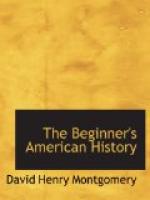PROFESSOR MORSE
(1791-1872).
220. How they sent the news of the completion of the Erie Canal to New York City; Franklin and Morse.—The Erie Canal, in the state of New York, connects the Hudson River at Albany with Lake Erie at Buffalo. It is the greatest work of the kind in America, and was completed many years ago. When the water was let into the canal from the lake, the news was flashed from Buffalo to New York City by a row of cannon, about five miles apart, which were fired as rapidly as possible one after the other. The first cannon was fired at Buffalo at ten o’clock in the morning; the last was fired at New York at half-past eleven. In an hour and a half the sound had travelled over five hundred miles. Everybody said that was wonderfully quick work; but to-day we could send the news in less than a minute. The man who found out how to do this was Samuel F. B. Morse.
[Illustration: HOW THEY FLASHED THE NEWS OF THE COMPLETION OF THE ERIE CANAL IN 1825.]
We have seen how Benjamin Franklin[1] discovered, by means of his kite, that lightning and electricity are the same. Samuel Morse was born in Charlestown, Massachusetts, about a mile from Franklin’s birthplace, the year after that great man died. He began his work where Franklin left off. He said to himself, Dr. Franklin found out what lightning is; I will find out how to harness it and make it carry news and deliver messages.[2]
[Footnote 1: See paragraph 119.]
[Footnote 2: Messages: a message is any word sent by one person to another.]
221. Morse becomes a painter; what he thought might be done about sending messages.—When Samuel Morse was a little boy, he was fond of drawing pictures, particularly faces; if he could not get a pencil, he would scratch them with a pin on the furniture at school: the only pay he got for making such pictures was some smart raps from the teacher. After he became a man he learned to paint. At one time he lived in France with several other American artists. One day they were talking of how long it took to get letters from America, and they were wishing the time could be shortened. Somebody spoke of how cannon had been used at the time of the opening of the Erie Canal. Morse was familiar with all that; he had been educated at Yale College, and he knew that the sound of a gun will travel a mile while you are counting five; but quick as that is, he wanted to find something better and quicker still. He said, Why not try lightning or electricity? That will beat sound, for that will go more than a thousand miles while you are counting one.
222. What a telegraph[3] is; a wire telegraph; Professor Morse invents the electric telegraph.—Some time after that, Mr. Morse set sail for America. On the way across the Atlantic he was constantly talking about electricity and how a telegraph—that is, a machine which would write at a distance—might be invented. He thought about this so much that he could not sleep nights. At last he believed that he saw how he could make such a machine.




